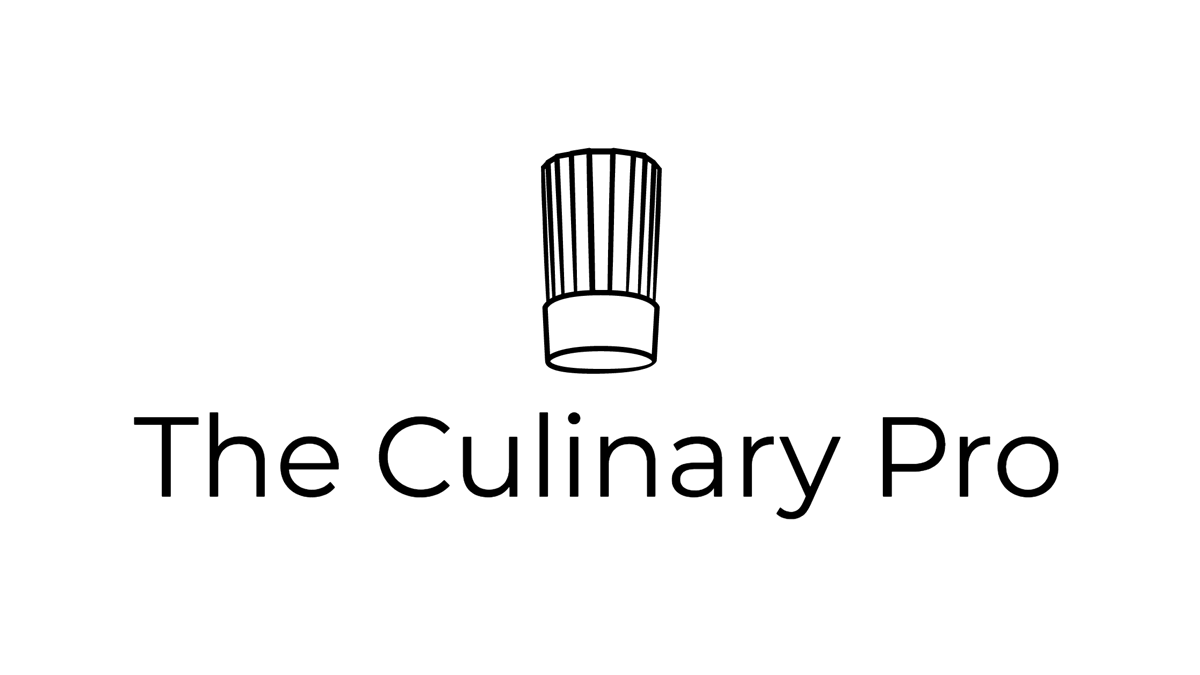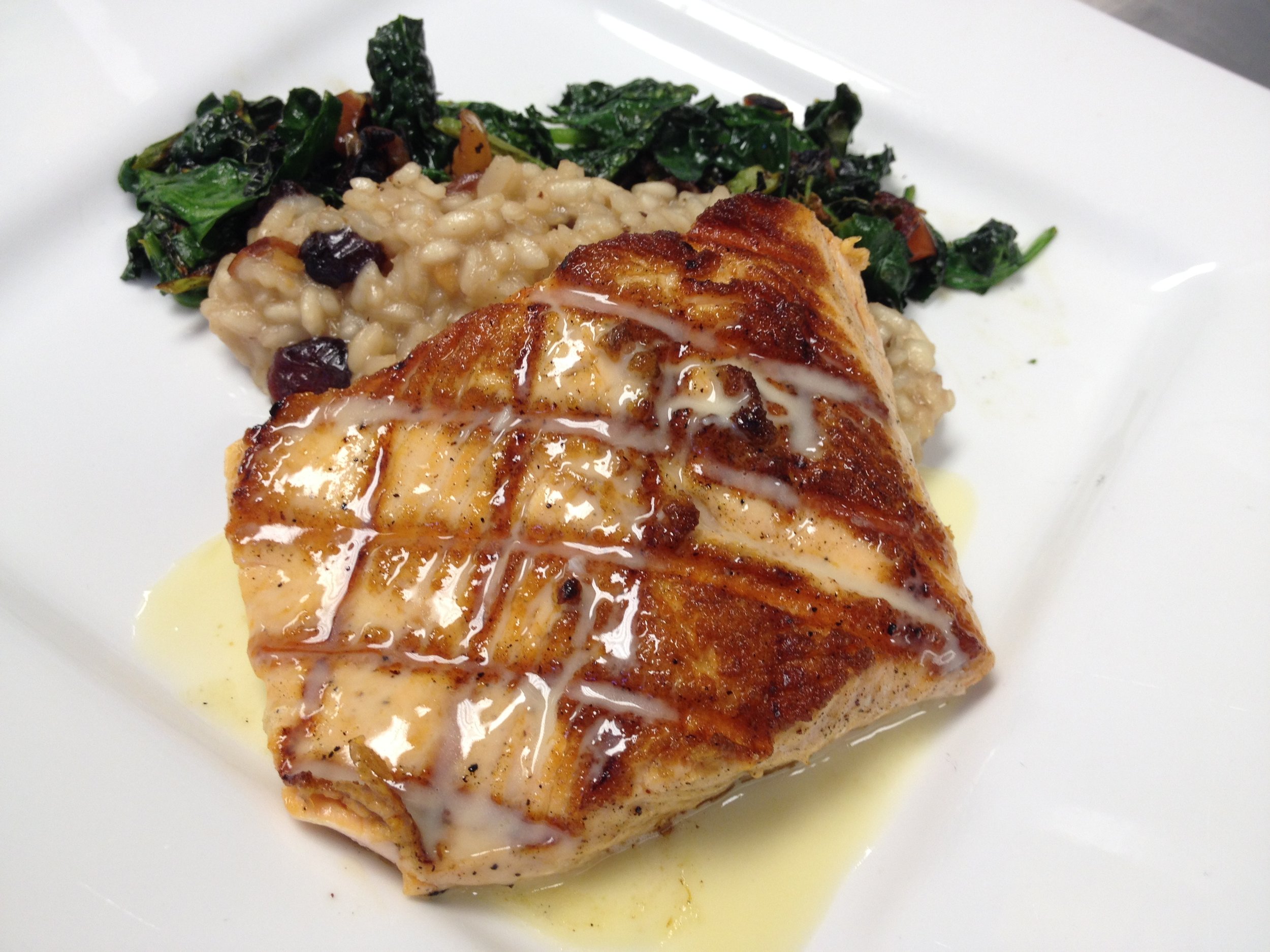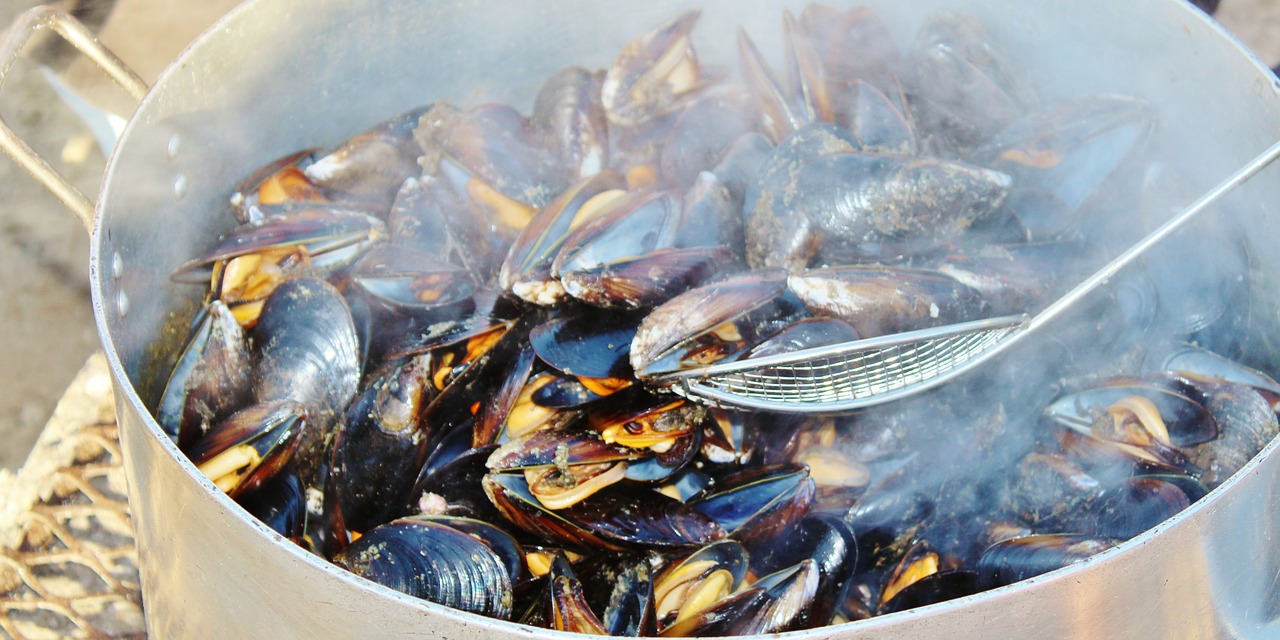Fish & Shellfish Cooking Methods
The delicate nature of fish and seafood requires extra care and attention during the cooking process. Because the muscles are much softer and the connective tissue is weaker than their land counterparts, it is easy to overcook and ruin their flavors and textures. The same techniques used for cooking meats and poultry can be applied to fish and seafood but cooking temperatures and times are generally reduced.
Fish Flavor
The perishability of fish and shellfish demands the freshest selection for the best results. Very fresh fish have flavors of grass and sea. Ocean fish generally are milder in flavor than their freshwater counterparts. Lean fish have a milder flavor than fatty fish, and freshwater bottom feeders including catfish have stronger flavors due to their diet. White fleshed fish like cod and sole have a milder taste than darker colored fish like tuna which possesses a more robust and meaty flavor.
The strong odor often associated with fish is found in the finned ocean varieties and to a lesser extent in mollusks and crustaceans. Saltwater fish possess molecules called Trimethylamine N-oxide (TMAO) on their skin to help them balance the salt and water in their bodies. When the fish die enzymes go to work breaking down TMAO to the odorous molecule Trimethylamine (TMA). Removing the skin, rinsing the fish before use, and keeping the fish iced are all ways to counteract the smell.
Heat transforms the flavor of fish and the longer it is cooked the stronger its taste. Frying and grilling create Maillard browning that mutes some of the fishy flavor. Marinating, brining, and poaching in court bouillon also counteracts these strong tastes. Aromatic vegetables, herbs and spices provide balance too.
Fish Texture
Unlike meats, that require several days to soften after the effects of rigor mortis set in, fresh killed fish require a matter of hours to soften their texture. And unlike meats, fish are not aged for extended periods as they are best served as fresh as possible. Salting or lightly brining the fish before cooking helps to firm the proteins and add moisture. But the best way to control fish texture is by avoiding overcooking.
Raw Preparations
Salmon Tartare
Scallop Ceviche
Because of the naturally tender characteristics of fish and seafood, many varieties are served in raw preparations including sashimi, sushi, and tartare. Ceviche is a popular raw dish that uses citric acids to marinade and “cold cook” the fish. Salted, cured or pickled fish are other international favorites. Raw clams and oysters on the half shell are popular too. All of these require the freshest fish of the highest quality and careful handling that include strict temperature control and high sanitation standards.
The US Food and Drug Administration (FDA) requires that fish intended for raw consumption be frozen to kill any parasites including worms for at least 24 hours below a temperature of -4˚F/-20˚C, and thawed under refrigeration for at least 12 hours. It is important to point out that that freezing doesn't kill all harmful microorganisms as some are killed only when fully cooked. Although the FDA rule does not apply to shellfish, mollusks also are susceptible to various types of viruses and parasites and should be treated carefully before preparation and consumption. Some shellfish are now being pasteurized or irradiated to reduce some of these health concerns.
Sashimi
Fish Cookery
There are hundreds of different types of fish with about 3 dozen regularly found in American markets. Since there are many more varieties of fish than meats or poultry, it's much harder to generalize about basic cooking techniques. The challenge is compounded by the fact that since they cook so quickly it is easy to ruin the texture, flavor, and moistness of the fish in a matter of seconds. Some fish like snapper are more forgiving if overcooked a little, others like tuna become very dry if cooked beyond a medium doneness, and still others like shark must be fully cooked to a higher temperature to soften their connective tissue. It is important to become familiar with the individual characteristics of common fish varieties so that the appropriate methods and cooking times can be chosen to maximize their quality.
Fish proteins coagulate at a lower temperature, generally between 120-130˚F/50-55˚C. Fats and gelatin in the muscles also melt at a lower point too. Fish proteins start to dry out and lose moisture at 140˚F/60˚C and will be very dry at 160˚F/71˚C. In a few cartilaginous fish, like shark and skate, cooking to 140˚F/60˚C is needed to soften their connective tissue. Some fish including tuna and swordfish are better when cooked to medium-rare while other fish like Chilean sea bass should be fully cooked otherwise it will be rubbery. Fatty fish take longer to cook than lean fish.
One important aspect that affects cooking time is the thickness of the cut of fish. A general rule of thumb is to allow approximately 10 minutes per 1 inch/2 cm of thickness when cooking but this is a very imprecise method. It is better to master the touch method for smaller cuts of fish and seafood and to know the texture and signs of fish that is cooked properly but not overdone. An instant-read thermometer is also a valuable tool for cooking whole fish and larger cuts of fish.
Shellfish Cookery
Most shellfish can be cooked using any of the basic techniques for fish while observing similar guidelines. Shellfish generally has more connective tissue and therefore will firm up when cooked. Small crustaceans and mollusks will be tenderer than larger ones. In all cases using slower and gentler cooking methods with a minimal amount of time will result in a moist and tender outcome.
Crustaceans should be cooked minimally because they can get dry and rubbery if overcooked.
Shrimp are commonly prepared by steaming, simmering, sautéing, grilling and poaching.
Lobsters can be poached, steamed, grilled, broiled and sautéed.
Because most crab meat is cleaned and cooked they can be used in a variety of preparations from simply heating the crab legs, or prepared in stuffing and crab cakes. Fresh crab can be steamed or in the case of soft-shell crabs sautéed or deep fried.
Mollusks will be chewy but tender when minimally cooked but can toughen when cooked too long. Similar to meat, they must be cooked for an extended period to tenderize them again.
Clams are used in chowders, soups, and stews. Smaller clams can be eaten raw or steamed. Larger clams can be stewed, braised or deep-fried. The large geoduck is usually pounded to tenderize it and sliced thin.
Mussels are commonly steamed or stewed and can also be fried
Oysters are eaten raw but can also be used in soups, stews, deep-fried or baked.
Octopus flesh is tenderized through pounding or tumbling. It is also tenderized through braising, simmering or steaming. Octopus can also be eaten raw in ceviche and sushi.
Squid, also called calamari, can be tenderized by scoring the connective tissue of the body. It is often deep-fried but can also be stewed or braised. Quick cooking is best because squid can become quite tough and will need to be cooked a long time to tenderize.
Cuttlefish can be treated similar to squid in cooking and handling techniques.
Conch meat has a mild, sweet clam-like flavor but is extremely tough and must be pounded, chopped, or marinated in lime juice to tenderize it before cooking. Some common preparations include fritters, chowder, steaks and marinated raw salads.
Sea urchin is eaten raw in ceviche-style preparations.
Cooking Methods
For more information on cooking proteins, review cooking methods for meats, poultry, and game.
Grill/Broil
Follow the basic rules for grilling meats and poultry but use a slightly lower temperature. Season and oil the fish before beginning. Use firm fish and shellfish that can hold up to the heat and won’t fall apart once on the grill. Grill baskets can be used for delicate fillets or whole fish to ease the turning process or can be placed on sizzler platters and set under a broiler to cook. Shrimp, lobster, and scallops do well on the grill because they have stronger connective tissue. Check for doneness by the touch method for smaller fillets and steaks, and for whole fish use a thermometer.
Grilling & Broiling Techniques
Grilling/Broiling Method
Preheat grill or broiler; clean and season the grates.
To ensure an even cooking process, cut fish fillets and steaks to a uniform thickness.
Salt the fish and allow to rest for 15-30 minutes to draw out excess moisture.
Pat the fish dry with a towel to remove excess surface moisture and oil the fish.
Depending on the delicacy, size, and heat source, grill directly on the grate; place in a basket, or on a broiler platter.
For smaller cuts use the touch method to determine doneness, for larger fish use an instant-read thermometer.
Remember to under-cook slightly to compensate for carryover cooking.
Roast/Bake
Oysters Rockafeller
A simple but effective way to cook fish, baking or roasting can be used as a stand-alone method or to finish fish after pan-searing on the stove top. Since the fish usually does not gain much color in the process, paprika is sometimes sprinkled on the surface. Herbs, spices, bread crumbs or nut crusts will also enhance the color, flavor, and texture of the fish. Convection ovens will produce more browning, or an initial pan-sear on the stove can also do the trick. The fish can be portion cut or cooked whole for a more rustic presentation. Large fish are often scored in the thickest part to accelerate cooking and ensure that the thinner tail section does not overcook.
Roasting Method
Pre-heat oven to desired temperature, for smaller fish or fillets 425-130˚F/50-55˚C
Prep fish and place on a sheet pan
Season and brush with oil
Place in oven and cook to the appropriate degree of doneness
Serve with a prepared sauce
Sauté
A popular method for cooking fish and shellfish, the fish can be dredged in flour just prior to cooking which adds texture, provides colors, and helps keep the fish moist. Sautéed fish a la Meuniere is a classic French technique garnished with brown butter, lemon and chopped parsley.
Sautéing Techniques
Skinless – This method is often used for cooking fish a la Meuniere, amandine, or with other ingredients including capers, tomatoes, or cucumbers.
To properly sauté make sure the pan is heated appropriately. The fish should sizzle when added to the hot pan. In the case of sole fillets they will only need a minute or two on each side to cook and should be lightly browned when done.
Skin-On – Fish that have tender skins, including snapper, salmon and trout can be sautéed with the skin intact providing a crisp texture that enhances the presentation. The technique must be properly executed and served immediately otherwise the skin will be soggy and unpalatable.
Pat the fish dry with paper towels.
Liberally season fish with salt and pepper.
Brush with oil or clarified butter.
Heat a well-seasoned sauté pan, add oil or clarified butter, and place the fish skin-side down to begin the searing process. Press lightly on the fillet with a fish spatula to flatten and evenly crisp the skin.
Turn the fish and continue to sauté while basting the skin with some of the butter in the pan.
If the fillet is large, place the pan in a hot oven to finish.
For plating always serve the fish skin-side up to preserve the crispness of the texture.
Serve with a prepared sauce.
Pan-Fry
By adding more oil to the pan and lowering the heat, fish can be coated with flour, breadcrumbs, or cornmeal and pan-fried to create a crisp texture.
Pan-Frying Techniques
Deep-Fry
Deep-frying, immersing food in in hot oil is popular in many cultures for preparing all types of fish and shellfish including shrimp, oysters, clams, and scallops. Breading or batter provides a crisp texture and the oil adds a savory quality to the palate. The method is best for small tender portions of food that cook in a matter of minutes.
Deep-Frying Techniques
Breaded
For breaded foods a three-stage breading process is used consisting of flour, egg wash and breadcrumbs. It is a convenient technique because the product can be prepared in advance and kept in a cold or frozen state. Foods are fried at a temperature of 350˚F/177˚C. For ease in dropping and removing foods from the deep-fryer use the “basket method”. A prepared sauce is served with the fish.
Batter-Fried
Batters are prepared with flour or other refined starches, water, beer or milk and eggs. Japanese tempura is a batter that is very light in color and texture. Beer batter is often used in fish fries. The batter is prepared in advance and the product is dipped in the batter just prior to dropping into the frying oil. For batter-fried foods, use the “swimming method” for deep-frying without a basket otherwise the batter will cling to a basket making it difficult to remove from the fryer. Serve with a prepared sauce as an accompaniment.
Simmer/Boil
Moist heat cooking methods are often used for many preparations. They are simple methods that can bring out the flavor and subtle texture of fish and seafood. Boiling is a crude method that can often overcook and damage the delicate textures of fish and seafood but simmering is a more gentle approach that will preserve the quality of the product and the temperature is much easier to control. Although crawfish boils in the southern US and fish boils in the New England and Midwest states are still used to prepare these delicious one pot dinners, more chefs are becoming attuned to lower temperature cooking for fish and shellfish.
Crawfish Boil
Whether simmering or boiling the cooking liquid is salted and enhanced by the addition of aromatic vegetables, lemon, herbs and spices and often combined with vegetables including potatoes, onions, carrots and corn. This method can be adopted for all types of shellfish including crabs, lobster, clams and shrimp.
Steam
Steaming is a healthy cooking method that brings out the natural characteristics of fish and shellfish. Because it is a naked method the product must be of the highest quality otherwise any off flavors will be readily evident. Steaming is a particularly popular method for cooking mussels and clams. Shell-on shrimp, crab, and lobster are also well-suited for this method. Steaming can be done in a chamber, a bamboo steamer, on a rack in a sealed pot, or by simply laying it in a sealed pan with a small amount of liquid. The preparation is enhanced through the use of aromatics, herbs, spices, butter and other flavorings.
Steamed Mussels
En Papillote
The classic technique of cooking en papillote is achieved by wrapping fish in a folded pouch of parchment paper with vegetables, herbs and spices. Although it is cooked in a dry oven it is actually a moist-heat method because the paper seals in the vapors and steams the fish.
Encasing the fish allows it to take on the character of the vegetables and seasonings surrounding it. Similar results can be achieved through the use of grape or banana leaves, corn husks, salt crusts, pastry, or foil. By wrapping in leaves, the technique can be adapted for grilling or steaming in a chamber.
Salmon En Papillote
Start with tender cuts of fish or shellfish. Since the method is a quick cooking technique, use tender vegetables including mushrooms and zucchini or blanched carrots cut into fine julienne. Aromatics including minced shallots, scallions, garlic or ginger and fresh or dried herbs accent the preparation. The dish can be enhanced with the addition of white wine, soy sauce, or citrus juices. The final presentation can also include a prepared sauce.
The method can be difficult to judge doneness which can result in overcooked fish. Testing temperature and times in advance will help achieve the desired outcome.
Poach
Two classic styles of poaching are submerge, also called deep poaching, and shallow poaching. Butter or oil poaching is a contemporary version of poaching and is similar to a confit in its method.
Submerge Poach
Sometimes call deep-poaching, this method is commonly used for whole fish and prepared by submerging the product completely in a court bouillon. The classic French dish “Truite au Bleu” is prepared in this fashion which requires a freshly killed and gutted trout. A sauce is prepared separately. If the whole fish are large, they are sometimes wrapped in cheesecloth to hold them together.
Shallow Poach
Shallow poaching is used for smaller cuts of fish that are folded or rolled into paupiettes. Mousseline forcemeat can be used as a filling for the paupiettes. A small amount to liquid, usually in the form of wine or stock is added to the pan along with shallots, garlic and a little butter. The fish is gently cooked either on the stove top or transferred to an oven. A sauce is prepared from the caisson (cooking liquid) in the pan.
Stew/Braise
Traditionally braises and stews are slow methods for cooking tough cuts of meats and poultry that can often take hours to complete. Adapting these methods for fish and seafood requires the cooking time to be shortened dramatically to create an optimal dish.
Braising & Stewing Techniques




















